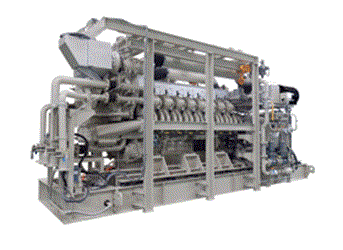MHI Develops High-Efficiency 2MW Gas Engine

Demonstration Testing of Prototype to Commence in September To Confirm World's Highest Level of Power Generation Efficiency
Tokyo Japan - Mitsubishi Heavy Industries, Ltd. (MHI), as part of the Strategic Innovation Program for Energy Conservation Technologies operated by the New Energy and Industrial Technology Development Organization (NEDO), has developed a 2-megawatt (MW) 16-cylinder high-speed gas engine achieving one of the world's highest power generation efficiency ratings in a high-speed gas engine. Through the adoption of technologies including two-stage turbocharging1 and Miller cycle2, the new engine offers power generation efficiency exceeding 44.7% (lower heating value3), one of the highest ratings for a high-speed gas engine for power generation and cogeneration applications.
Demonstration testing using a prototype of the new engine will get under way in September. Ultimately MHI is targeting commercial production of the engine for applications including distributed generation, regular generation and cogeneration, and emergency generation during times of disaster.
Notes:
- Two-stage turbocharging: In two-stage turbocharging, turbochargers are arranged in series in the low- and high-pressure stages and an intercooler is placed between them, creating a configuration that achieves outstanding efficiency and a high pressure ratio.
- Miller cycle: Whereas in the normal (Otto) cycle the compression ratio and expansion ratio of the cylinders are equal, in the Miller cycle the profile of the valve cam is engineered so that the timing of the valve closing shifts in such a way that the expansion ratio becomes greater than the compression ratio - a configuration aimed at enhancing thermal efficiency.
- Lower heating value (LHV): LHV is one way of expressing the gross thermal efficiency of internal combustion power generation. It refers to the calorific value at which fuel combusts adequately to convert to work. In relation to the thermal efficiency of an engine, LHV derives from the value of work calculated as calorific value divided by the calorific value of the supplied fuel.
1. Overview
In Japan, the importance of securing electricity supplies and distributed power generation sources has intensified in the wake of the Great East Japan Earthquake of 2011, and at both the national and local levels governmental bodies are devising measures to encourage the introduction of cogeneration systems. Overseas, substantial expansion in the market for gas engine power supplies is anticipated against the backdrop of the promotion of distributed power generation systems responding to shale gas development in North America and to expanding power consumption in China and other Asian countries.
MHI's newly developed 16-cylinder high-speed gas engine has achieved a power generation efficiency rating in excess of 44.7% (LHV), one of the highest ratings in a gas engine for use in power generation and cogeneration. This achievement has been made possible through the development of two-stage turbocharging technology enabling the adaptation of a high Miller cycle, the development of elemental technologies for a high power ratio to raise mechanical efficiency, and the achievement of high power generation efficiency.
2. Latest Breakthroughs
Development of two-stage turbocharging technology enabling adaptation of a high Miller cycle
The adaptation of a high Miller cycle enabling outstanding power generation efficiency requires a turbocharging system to feed the necessary air efficiently to the combustion chamber. MHI succeeded in developing two-stage turbocharging technology achieving an outstanding pressure ratio and high efficiency rating by installing high-efficiency turbochargers applying expertise in automotive compressors in both the low- and high-pressure stages.
Development of elemental technologies for a high power ratio to raise mechanical efficiency
The newly developed 2MW-class gas engine cuts the engine's mechanical loss ratio, and thus raises mechanical efficiency, by improving engine output while maintaining the same exhaust volume as the GS16R2, a 1.5MW-class gas engine developed by MHI in 2012. To cope with the increased combustion pressure and thermal load accompanying higher output, elemental technologies were developed for important parts such as high-strength cylinder heads and steel pistons achieved through thermal structural analysis, cooling system analysis, etc. These parts will next undergo durability testing and evaluation.
High power generation efficiency
As a result of the two breakthroughs described above, the newly developed engine offers 0.5MW higher power generation output and 4.4-point higher gross thermal efficiency than the current high power-outputting GS16R2 (40.3%), all with the same exhaust volume and same engine rotation speed.
3. Future Plans
Plans call for the installation of a prototype at MHI's Sagamihara District in Kanagawa Prefecture, where the company has an engine production base, for use in its non-utility power generation facility, with demonstration testing to continue through February 2015. After demonstration testing, which will include tests of the prototype's power output, efficiency and all other performance categories, the system will be used as the power source of a model power generation and cogeneration package set to undergo demonstration operation.
MHI further plans to steadily expand from the newly developed 16-cylinder model to a full series of 6- to 24-cylinder models offering outputs ranging from 0.75 to 3 MW. In this way MHI will expand its lineup to accommodate a broad array of needs, both in Japan and overseas, for distributed power supplies, regular power generation and cogeneration systems, and emergency power supplies in preparation for disasters of all kinds.
Source: Mitsubishi Heavy Industries, Ltd. (MHI)
